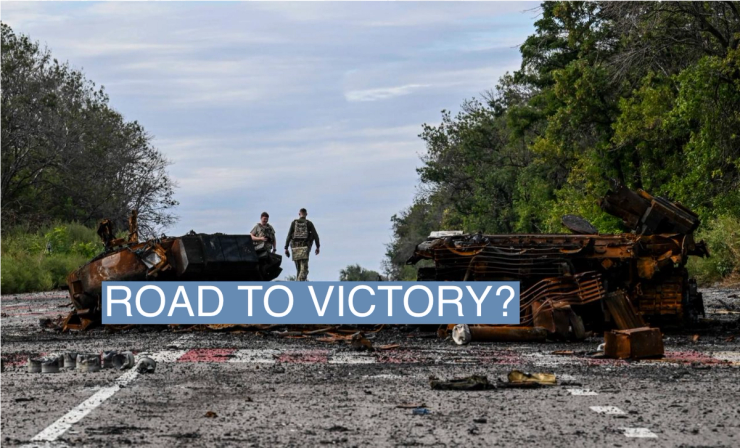The Subject
Ukraine has embarked on its long-awaited counteroffensive, a critical effort to regain territory and show Kyiv’s international supporters it’s capable of making progress in its grinding war with Russia. Seth Jones, director of the International Security Program at the Center for Strategic and International Studies in Washington, recently toured Finland, Poland, the Baltic States, and met with senior Ukrainian defense officials in Europe, to gauge the prospects for Ukraine’s effort, publishing his conclusions in a report CSIS published last week.
Jones told Semafor in an interview on Monday that he entered his study “pretty gloomy” about Ukraine’s hopes for regaining significant amounts of territory. But after analyzing the Ukrainian battlefield, and consulting military historians who’ve tracked previous battles involving entrenched positions like Russia has constructed, he came away thinking “it is possible” Kyiv can make real gains. He cited the sheer breadth of the military line the Kremlin needs to hold — 2,000 kilometers — and the low quality and morale Russian forces have displayed over the past 16 months.
“I think if they go for 20% to 15% or 10% of their territory, that’s pretty decent,” he said. “You can get half that territory back. That’s pretty big.”
This interview has been edited for length and clarity.
The Interview
Jay Solomon: Where do you assess we are in the Ukrainian counter-offensive?
Seth Jones: Where I really look at the situation as it stands right now is the Ukrainians probing the front lines and conducting limited offensive operations and more just fighting, probing for weaknesses. I still think we’re in the early stages before the Ukrainians are really committing their best forces into a blitzkrieg and punch through lines and then just start moving.
Jay Solomon: Does Ukraine have a grand strategy for this offensive?
Seth Jones: I do think we’re all in the guessing game a little bit, but I have talked to enough senior officials, both within Ukraine and then in NATO countries, including the U.S., that suggest there is a game plan for the offensive. Like any plan, though, it has to change pretty quickly, by the day. Once the fighting’s started, it becomes fluid. It’s like the old Mike Tyson quote: everybody [plans] until you get punched in the mouth.
Jay Solomon: What do you think would qualify as a successful counter-offensive for the Ukrainians?
Seth Jones: I think if they go for 20% to 15% or 10% of their territory, that’s pretty decent. They’ve just talked about 20% or so, give or take a few percentage points. But [if] you can get half that back — that’s pretty big.
Jay Solomon: Over what time frame is this achievable?
Seth Jones: I think three to four months. The problem is if this dragged out any longer you’re really talking about attrition warfare. And that’s where the Ukrainians can’t really pull it out. They still don’t have the kind mass numbers of forces. That’s why they need maneuverability.
Jay Solomon: How deep and extensive are Russia’s defenses along these lines?
Seth Jones: I don’t want to overstate the quality of the Russian fortifications or the Russian forces. There’s a pretty extensive mixture — as we took a look at locations, and then at satellite imagery — extensive network of let’s say, the Dragon’s Teeth. They’re generally several rows; we were seeing three rows. I can see these are pyramid-like concrete structures that are done properly and go reasonably deep and often connected by concrete. And their purpose really is to make it impossible for tanks to go over.
So then you’ve got the trenches where the Russian forces have dug up berms and where there are earthwork barriers that the Russians have constructed. And you’ve got artillery placed, sometimes hidden, where deception becomes important because the Ukrainians are going to have access to U.S. imagery analysis, including satellite imagery analysis.
Jay Solomon: What advantages do the Russians have?
Seth Jones: I think their biggest advantage right now is the Ukrainians have not been able to move quickly yet. It means they are now close to Russian firepower. Not just from the air, but from artillery, long range artillery. The Ukrainians are going to have to start to move faster than they are right now.
Jay Solomon: What advantages do the Ukrainians have?
Seth Jones: I think there are several. One of them is just the size of the [Russian] line, huge. It’s like over twice the size of the Maginot Line that the French constructed, both on the German border as well as Belgium, that the Germans penetrated. They don’t have enough forces to defend all areas of the line.
A second is the terrain. There will be some advantages, particularly really mountainous terrain. But that’s a challenge for the Russians. It’s not ideal for a defense because there are not a lot of natural barriers [where] they can hide.
A third and significant challenge for the Russians is just the quality of their ground forces has been deeply mixed. There has been a problem just general morale, depletion of the Russian forces. And even the significant role we’ve seen of the Wagner Group is not a good sign.
Jay Solomon: What’s a likely scenario with that defensive line so hard to defend?
Seth Jones: I think it’s likely that the Ukrainians will break through somewhere and be able to push through the open terrain. I think the question becomes: How quickly can the Russians move reinforcements to limit any Ukrainian breakthroughs? That’s the variable that’s going to be hard to predict.
Jay Solomon: What part of the Russian defenses will be the most difficult to penetrate?
Seth Jones: You’re going to try to take Crimea? You’re going to have to go through a very intense network of fortifications that also have a lot of the long-range fire from Russian naval vessels in the Black Sea. It’s going to be pretty heavily saturated with fire, long range fire.
Jay Solomon: What outside assistance from the U.S. or NATO could have the most impact for Ukraine?
Seth Jones: ATACMS [tactical ballistic missiles] would be fantastic. They would really give longer ranges for Ukrainian forces.
Jay Solomon: And assistance to the Russians?
Seth Jones: Chinese assistance on parts for weapons systems — oscillators, gyroscopes — things that the Russians had used on some of their weapons systems from the West and now they can’t because they’re sanctioned.
Jay Solomon: What’s surprised you about your study and the status of the conflict?
Seth Jones: I went in pretty gloomy and came out of it saying: Oh, you know, actually. We talked to a range of military historians as well. And, I mean, there are a lot of cases in history where you saw attackers facing pretty significant infrastructure [and fortifications] and it is possible [to make gains].


